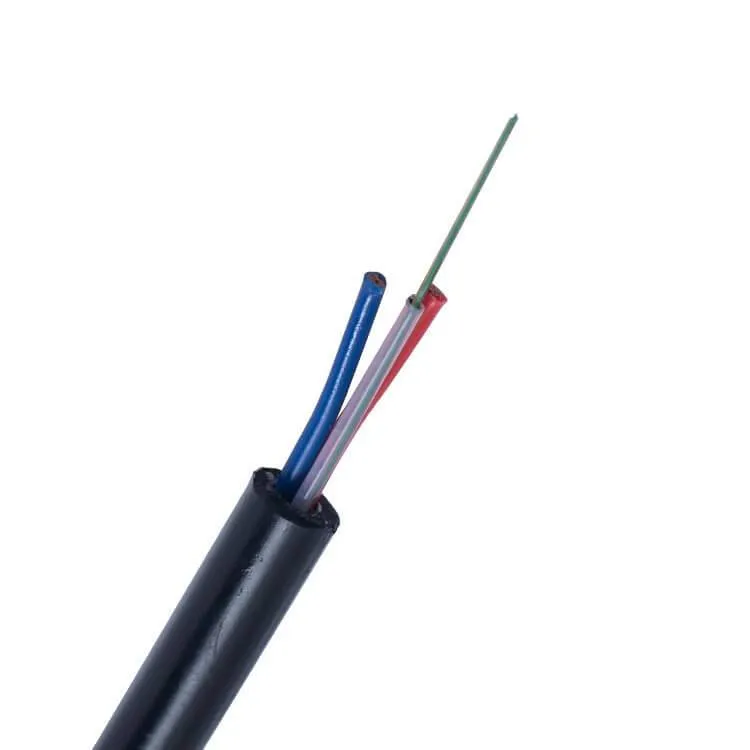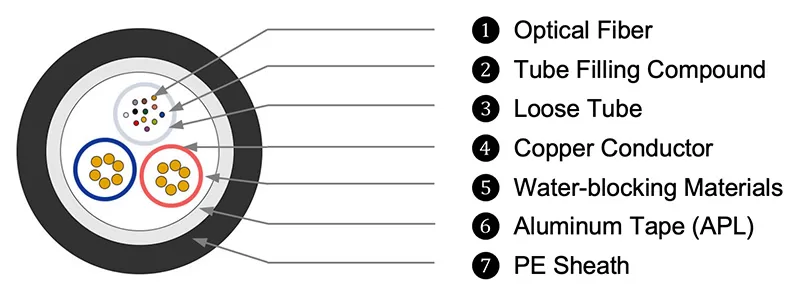
China Hybrid Fiber Optic Cable Manufacturer
We’re Hybrid Fiber Optic Cable Manufacturer located in China. Your trusted source for high-quality, custom hybrid fiber optic cables. We offer competitive pricing, fast delivery, and exceptional customer support.

Hybrid Fiber Optic Cable Specifications
Hybrid fiber optic cable is a new type of cable that combines optical fibers and copper wires in a single design. It’s used in broadband networks to deliver high-speed internet access. This innovative cable solves two problems at once: providing internet connectivity and powering remote devices.
The cable’s structure includes optical fiber strands, copper wire strands, and filler material bundled together around a central support. A water-resistant layer protects the inner components and is covered by an outer plastic sheath.
Custom Hybrid Fiber Optic Cable

Our custom hybrid fiber optic cables offer a versatile and efficient solution for transmitting both data and power simultaneously. By combining fiber optic and copper conductors within a single cable, we deliver a streamlined approach to complex connectivity challenges.
Whether you need to power remote devices, transmit high-speed data over long distances, or integrate multiple signal types, our custom hybrid fiber optic cables provide a reliable and efficient solution.
Let us help you design the perfect cable for your project.
Hybrid Fiber Optic Cable: A Comprehensive Guide
1. What is Hybrid Fiber Optic Cable?
A hybrid fiber optic cable is an innovative cable that combines the strengths of both optical fiber and copper conductors within a single structure. This unique combination allows for the simultaneous transmission of data and electrical power, making it a versatile solution for various applications. Essentially, it’s a cable that can carry both light signals (for data) and electrical current (for power).
2. How Can Hybrid Fiber Optic Cable Has Great Performance?
Hybrid fiber optic cable offers exceptional performance due to the complementary properties of its components:
- High-speed data transmission: Optical fibers provide incredibly fast and reliable data transfer with minimal signal loss.
- Power delivery: Copper conductors ensure efficient and stable electrical power supply.
- Space efficiency: Combining both functionalities in a single cable saves installation space and reduces costs.
- Reduced installation time: Fewer cables to install means faster project completion.
- Improved reliability: Fewer connection points and potential failure points enhance overall system reliability.
3. What are the Applications of Hybrid Fiber Optic Cable?
The versatility of hybrid fiber optic cable makes it suitable for a wide range of applications, including:
- Power over Ethernet (PoE): Providing both data and power to network devices like IP cameras, access points, and VoIP phones.
- Industrial automation: Controlling and monitoring industrial processes, including sensors, actuators, and control systems.
- Renewable energy: Transmitting data and power from solar panels, wind turbines, and other renewable energy sources.
- Telecommunications: Supporting high-speed data transmission and power distribution in telecommunication networks.
- Oil and gas industry: Providing communication and power in challenging and remote environments.
4. What are the Advantages of Hybrid Fiber Optic Cable?
Hybrid fiber optic cable offers several key advantages:
- Cost-effective: Reduces overall project costs by eliminating the need for separate data and power cables.
- Time-saving: Streamlines installation and reduces labor costs.
- Improved efficiency: Optimizes space utilization and simplifies cable management.
- Enhanced reliability: Minimizes connection points and potential failure points.
- Future-proof: Can accommodate increasing data demands and power requirements.
5. What are the Types of Hybrid Fiber Optic Cable?
The specific configuration of a hybrid fiber optic cable can vary depending on the application. However, common types include:
- Hybrid fiber coaxial cable (HFC): Combines optical fiber and coaxial cable for broadband internet access.
- Hybrid power and data cable: Integrates optical fibers and copper conductors for power and data transmission in industrial and commercial settings.
- Hybrid outdoor cable: Designed for outdoor use, often with additional protection for harsh environments.
6. What are the Materials for Hybrid Fiber Optic Cable?
The materials used in hybrid fiber optic cables vary depending on the specific application and performance requirements. However, common materials include:
- Optical fiber: Made from high-purity silica glass for efficient light transmission.
- Copper conductors: Used for carrying electrical current, typically made from copper or aluminum.
- Insulation: Protects the conductors and fibers, often made from polyethylene or fluoropolymer materials.
- Jacket: Provides overall cable protection, typically made from PVC, polyethylene, or other durable materials.
By understanding the characteristics and benefits of hybrid fiber optic cable, you can make informed decisions about its suitability for your specific needs.



